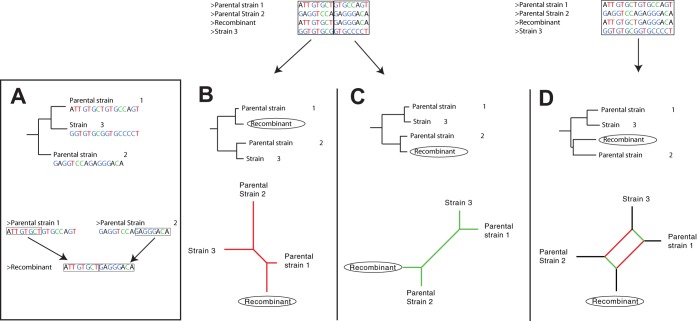FIG 1.
Schematic illustration demonstrating the fundamental basics of phylogenetic representations of recombination events and the limitations of traditional bifurcating phylogenetic trees. (A) Traditional phylogenetic tree illustrating the evolutionary history of three fictional small genomes, parental strain 1, parental strain 2, and strain 3 (top) and a recombination event between parental strains 1 and 2, in which the strain recombinant is created by concatenating the first genomic segment of parental strain 1 with the last genomic segment of parental strain 2 (bottom). (B and C) Rooted traditional bifurcating phylogenetic trees (top) and unrooted phylogenetic networks (bottom) based on the first (B) and last (C) parts of the genomes, respectively (i.e., before and after the recombination breakpoint). Here, all phylogenies reflect the true evolutionary history of the respective genomic segment, but none reflect the correct evolutionary history for the complete genomes. The traditional bifurcating phylogenetic tree based on the complete genome (D, top) cannot illustrate recombination events but instead places the recombinant strain separately from the other strains since it contain parts from both parental strains, which the algorithms interpret as separate evolution. Hence, this tree does not reflect the true evolutionary history of any genomic segment. The use of traditional phylogenetic trees should therefore be avoided when recombinant genomes are included in the analysis. The phylogenetic network (D, bottom), however, correctly illustrates the evolutionary relationships between the different strains. The parallel edges in the network illustrate the conflicting phylogenetic signals resulting from the multiple evolutionary histories found in the recombinant strain. In phylogenetic networks, parallel branches or internal “boxes” thus indicate that the data sets have conflicting phylogenetic signals. These conflicting signals may be a result of either convergent evolution or recombination.

